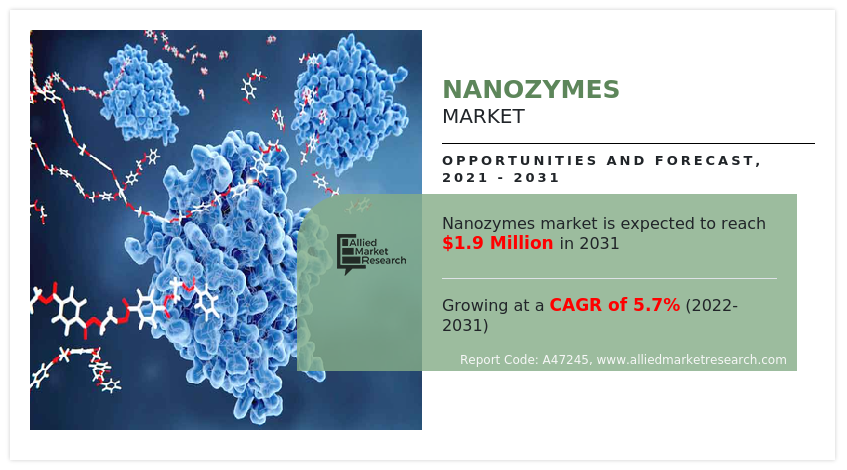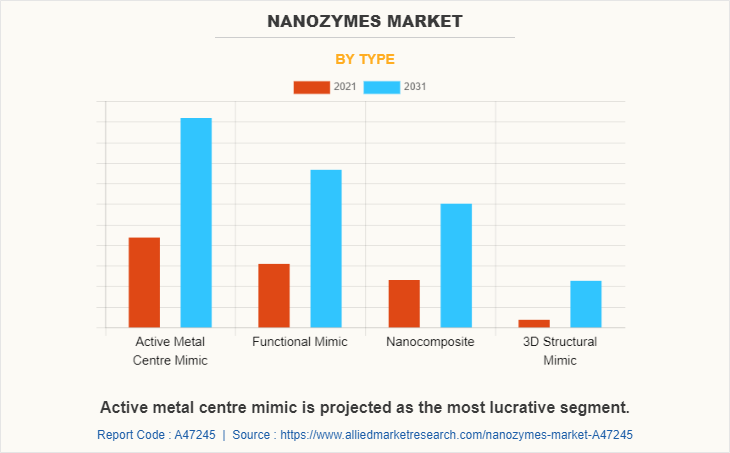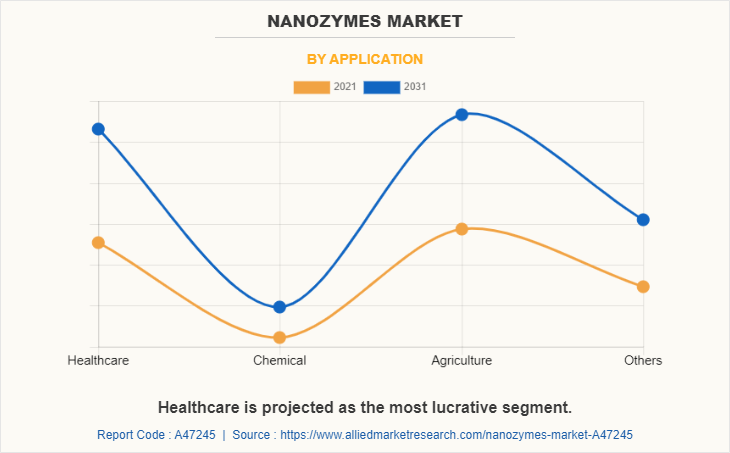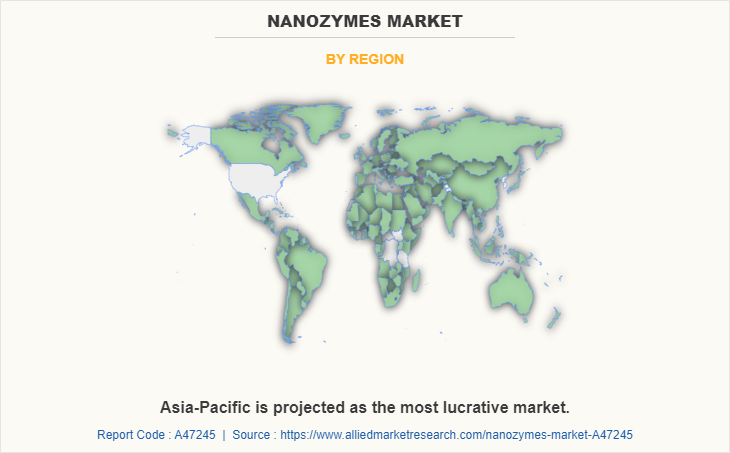Nanozymes Market Research, 2031
The global nanozymes market size was valued at $1.1 million in 2021, and is projected to reach $1.9 million by 2031, growing at a CAGR of 5.7% from 2022 to 2031.
Report Key Highlighters:
- The nanozymes market has been analyzed in value ($million).
- Global nanozymes market is fragmented in nature with many players such as Profacgen, Max Systems LLC, FutureX Industries, Nano Medichem (P) Ltd., and Emergene Agrinovo Private Limited. Also tracked key strategies such as product launches, acquisitions, mergers, expansion etc. of various manufacturers of Nanozymes.
- Included more than 20 countries in the report which covers market volume as well as market value for all the countries of nanozymes market.
- Covered the detailed list of manufacturers by application of nanozymes market. It covers the product information, application, and geographical presence of the companies.
- Conducted primary interviews with raw material suppliers, wholesalers, suppliers, and manufacturers of nanozymes market to understand the market trends, growth factors, pricing, and key players competitive strategies.

Nanozymes are nanomaterials that display enzyme-like characteristics. They are an important way of connecting nanomaterials to biological systems. Many nanozymes mimic natural enzymes such as catalase and peroxidase, but future developments will lead to the production of novel artificial enzymes at the nanoscale. Nanozymes are currently being employed in biomedicine through the detection of targets such as small biomolecules, metal ions, and cancer cells. Nanozymes provide several advantages over natural enzymes. They are recyclable and less expensive. The production of nanozymes is cost-effective and these can be stored for extended periods of time.
Typical inorganic enzymes require high temperature, high pressure, and extreme pH conditions. In contrast, nanozymes can work in environments closer to physiological conditions and respond to a range of external stimuli. The most important advantage is the display of size and composition dependent activity meaning that nanozymes can be designed with a range of catalytic activity by simply varying shape, structure, and composition. Furthermore, nanozymes also have unique properties compared to other artificial enzymes including integrated multi-functions not related to catalysis. Nanozymes provide large surface areas allowing greater ease in further modifications and bioconjugation. In addition, the capacity to self-assemble mimics a crucial biological mechanism, making it simple to incorporate biological components.
In many applications, such as those used in the biomedical industry for drug delivery, biosensing, and diagnostic medications, nanozymes are taking the place of natural enzymes. Due to the significant demand for nanozymes across a variety of industries, including the biomedical and pharmaceutical sectors, which benefit from their high strength and chemical resistance, the market for nanozymes is expanding. The ability to detect disease in its early stages is particularly important for improving clinical outcomes. Biosensors are being designed that are rapid, reliable, and highly sensitive through the employment of nanozymes. This factor is projected to boost the market growth during the forecast period.
Increase in demand for nanozymes in biomedical industry
Nanozyme is a series of nanomaterials with enzyme-mimetic activities that can proceed with the catalytic reactions of natural enzymes. In the field of biomedicine, nanozymes are capturing tremendous attention due to their high stability and low cost. With the advancement of nano chemistry, artificial nanozymes with high catalytic stability, low manufacturing and storage cost, and greater design flexibility over natural enzymes, have emerged as a next-generation nanomedicine. Enzyme-mimetic activities of nanozymes can be regulated by multiple factors, such as the chemical state of metal ion, pH, hydrogen peroxide (H2O2), and glutathione (GSH) level, presenting great promise for biomedical applications. Over the past decade, multi-functional nanozymes have been developed for various biomedical applications such as drug delivery, biosensing detection and others.
Notably, chemically designed nanozymes with robust catalytic activity, tunable specificity and multi-functionalities are promising for biomedical applications including biosensing, infectious disease therapy, cancer therapy, neuroprotection, injury therapy and so on. With the increasing demands of using enzyme for biomedical applications in harsh biological microenvironments, the chemically designed nanozymes with robust catalytic activity, tunable specificity and multi-functionalities are very promising. For example, compared with conventional chemotherapeutic agents, nanozymes can perform localized catalytic activities specifically at disease sites, showing reduced side effects in vivo. Moreover, the multifunctional catalytic activities of nanozymes bring synergistically enhanced therapeutic effects for disease treatment. Thus, an increase in the adoption of nanozymes in the biomedical industry is projected to boost the nanozymes market growth during the forecast period.
Benefits of nanozymes:
Nanoparticles exhibiting the properties of an enzyme are termed as “nanozymes.” Nanozymes offers several advantages over natural enzymes, therefore, a rapid expansion of the development of artificial biocatalysts. These advantages include simple methods of synthesis, high enzyme-mimicking activity, low cost, high stability, robust catalytic performance, and smooth surface modification of nanomaterials. Due to its powerful and distinguished functions, nanozymes exhibit widespread applications in the field of biosensing and immunoassay, attracting researchers in various fields to design and engineer nanozymes. Recently, nanozymes have been innovatively used to bridge nanotechnology with analytical techniques to achieve the high sensitivity, specificity, and reproducibility.
Nanozymes are nanomaterials with intrinsic enzyme-like properties. They can specifically catalyse substrates of natural enzymes under physiological condition with similar catalytic mechanisms and kinetics. Compared to natural enzymes, nanozymes exhibit unique advantages including high catalytic activity, low cost, high stability, easy mass production, and tunable activity. In addition, as a new type of artificial enzymes, nanozymes not only have enzyme-like catalytic activity, but also exhibit the unique physicochemical properties of nanomaterials, such as photothermal properties, superparamagnetic, and fluorescence, and others. By combining the unique physicochemical properties and enzyme-like catalytic activities, nanozymes have been widely developed for in vitro detection and in vivo disease monitoring and treatment. Thus, these advantages of nanozymes will drive the market growth during the forecast period.
The nanozymes market is segmented on the basis of type, application and region. On the basis of type, the nanozymes market is classified into active metal center mimic, functional mimic, nanocomposites, and 3D structural mimic. On the basis of application, the market is categorized into healthcare industry, chemical industry, agriculture, and others. Region-wise, it is analyzed across North America, Europe, Asia-Pacific, and LAMEA.
The major players operating in the industry include Profacgen, Max Systems LLC, FutureX Industries, Nano Medichem (P) Ltd., and Emergene Agrinovo Private Limited. These players have adopted product launch, acquisition, and business expansion as their key strategies to increase their market shares.

Nanozymes Market By Type
The market is divided into Active Metal Centre Mimic, Functional Mimic, Nanocomposite, and 3D Structural Mimic. Active Metal Centre Mimic type was the largest revenue generator, in 2021 and is anticipated to register a CAGR of 6.1% during the forecast period. The surge in application areas of nanozymes manufactured with metal nanoparticles and increasing demand for active metal center mimic nanozymes from healthcare and pharmaceutical industries are the major factors driving the growth of nanozymes market over the projection period.

Nanozymes Market By Application
On the basis of applications, the global nanozymes market is divided into healthcare, chemical, agriculture and others. High flash point grade nanozymes was the largest revenue generator, in 2021 and is anticipated to expand at a CAGR of 5.7% during the forecast period. Nanozyme is a bridge between nanotechnology and biological nitrogen fixation, which regulates the reactive oxygen metabolism and protects nitrogenase, thereby significantly enhancing the symbiotic nitrogen fixation efficiency by 260%. The advantages of nanozymes in an agricultural application will drive the market growth during the forecast period.

Nanozymes Market By Region
Region-wise, the nanozymes market is analyzed across North America, Europe, Asia-Pacific, and LAMEA. The Asia-Pacific nanozymes market size is projected to expand at the highest CAGR of 5.6% during the forecast period. The rise in consumer awareness regarding health boosts the usage of nanozymes for the detection of food contaminants in food products, and thus is anticipated to positively impact the demand for nanozymes during the forecast period in the region.
Key Benefits For Stakeholders
- This report provides a quantitative analysis of the market segments, current trends, estimations, and dynamics of the nanozymes market analysis from 2021 to 2031 to identify the prevailing nanozymes market opportunities.
- The market research is offered along with information related to key drivers, restraints, and opportunities.
- Porter's five forces analysis highlights the potency of buyers and suppliers to enable stakeholders make profit-oriented business decisions and strengthen their supplier-buyer network.
- In-depth analysis of the nanozymes market segmentation assists to determine the prevailing market opportunities.
- Major countries in each region are mapped according to their revenue contribution to the global market.
- Market player positioning facilitates benchmarking and provides a clear understanding of the present position of the market players.
- The report includes the analysis of the regional as well as global nanozymes market trends, key players, market segments, application areas, and market growth strategies.
Nanozymes Market Report Highlights
| Aspects | Details |
| Market Size By 2031 | USD 1.9 million |
| Growth Rate | CAGR of 5.7% |
| Forecast period | 2021 - 2031 |
| Report Pages | 170 |
| By Type |
|
| By Application |
|
| By Region |
|
| Key Market Players | Profacgen, Nano medichem, Max Systems LLC., FutureX Industries, Emergene Agrinovo Private Limited |
Analyst Review
Major players in the nanozymes market are focusing on the needs of their customers, which has resulted in a high level of innovation in terms of the product' high stability, high accuracy, and low cost. In addition, there is surge in the application of nanozymes in a number of industries, including healthcare, agriculture, food, and waste water treatment. The primary driver of market expansion is the growing application in the biomedical industry. Increase in research and development activities from universities and manufacturers to further improve the efficiency of nanozymes will boost the market growth over the projection period. However, the presence of alternative enzymes is expected to restrain the market growth.
The industry is characterized by a high number of new market entrants that are seeking to tap lucrative opportunities in the global market while existing players are entering into strategic collaborations to increase capacities & expand their reach into emerging markets. Joint venture, merger, and acquisition activities in the industry have increased significantly over the past decade. Companies constantly seek to establish long-term contract agreements with trusted partners for sustainable business operations globally.
The increase in demand for nanozymes from food and beverages industry is driving the market growth.
Asia-Pacific is the largest regional market for nanozymes.
The global nanozymes market was valued at $1.1 million in 2021, and is projected to reach $1.9 million by 2031, growing at a CAGR of 5.7% from 2022 to 2031.
Profacgen, Max Systems LLC, FutureX Industries, Nano Medichem (P) Ltd., and Emergene Agrinovo Private Limited are the top companies to hold the market share in Nanozymes.
The global nanozymes market is segmented on the basis of type, application and region.
Loading Table Of Content...



